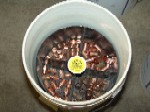
Inside the office of MacGregor Plumbing, Heating and Air Conditioning, Harbor Springs, Mich., are two steel boxes on the wall near the dispatcher's desk. That's where the company keeps the keys to more than 450 homes of its customers. Since this is a summer resort town, three-quarters of MacGregor's customers aren't often near these homes when they need service.
“Building that sort of trust from customers means you've delivered that same trust by being there when the customer needs you,” says Julie Weiman, general manager of the company her father, John MacGregor, started more than four decades ago. Some of the customers that it serves today were her dad's first customers.

To accomplish this, MacGregor has made a commitment to hire professionals and not your typical “fix-it” people. The company makes a considerable investment in training to teach technicians to focus on customer service.
“'Fix-it' technicians charge into a customer's home with tunnel vision,” Weiman says. “They run in, fix something, and run out. We look for technicians who will build a rapport with our customers. We look for the personable technicians who will explain what they are going to do, get the customer to buy into the option presented and make him or her feel they are a part of the sale.”
While all those house keys represent the company's dedication to customer service, this Nexstar-member company implemented an uncommon employee health insurance program to attract and keep those exemplary service technicians. This insurance program also saved the company $62,000 in the first year alone. MacGregor also has taken steps to tighten its inventory control and reduce shrinkage to less than 1 percent.
Healthcare For Less
After 20 years of shelling out for a company-sponsored employee health insurance plan, Weiman began searching for an alternative after the company was hit with a 37 percent premium increase in 2003. What she found was a plan that provided better coverage for all 37 of MacGregor's employees, and saved the company $62,000 in the first nine months.In November 2003, Weiman began looking into health insurance options and found the Web site www.ehealthinsurance.com. This site offers visitors a comparison look at health insurance options and premiums from different insurance companies. During Weiman's investigation, she discovered that in her area, individual health insurance policies cost less than group insurance plans.
At the time, for example, Weiman knew the company was paying $663 per month for her own family of four. The Web site comparison showed a similar plan on an individual policy that would drop the monthly premium to only $175 per month. The existing and proposed policies were from the same insurance company. Prescription coverage and doctor visits were not covered under the individual policy, but offered a lower deductible than the group policy, and the deductible was set at a maximum out-of-pocket expense the policyholder had to pay.
The Web site also gave Weiman information on setting up a company-sponsored health reimbursement account (HRA), as well as the necessary IRS material explaining about forming the accounts. HRAs operate similarly to 401(k) accounts. After setting up the HRA account at a local bank, the company and bank designed the plan, then had it approved by the IRS. Employees are now responsible for purchasing their own individual health insurance policies and the premiums are reimbursed out of the company's HRA account. Each employee is also reimbursed for a variety of health-related expenses up to a maximum each year. The bank handles account administration, and the company contributes a consistent amount to the account each month.
“There's no internal administration,” Weiman says. “No insurance increase headaches. No insurance agents to deal with. No sales calls. That stuff is all gone.”
When she was ready to roll the employee's health insurance program over to the HRA, Weiman held three employee meetings to explain the program. She ran off examples of how the program would work for single employees, through multiple family members, and at all age groups. She ran off an example for every employee based on the information she had in his or her employment file. She also had an independent agent come in to offer advice to any employee who still had questions. Finally, a bank representative came to another meeting to explain how the reimbursement process worked. The rollover went smoother than expected.
“It's just so simple and cost-effective,” Weiman says, “I can't imagine ever going back.”
The program began in March 2004. By the end of that year, MacGregor had saved $40,000 in insurance premiums it would have spent on its old group insurance. Another $22,000 of unspent money accumulated in the HRA account. That's a realized savings of $62,000; however, the company left the $22,000 in the HRA account as a rollover for the employees and gave them a head start for 2005.

Controlling Inventory
A few years ago, MacGregor's inventory was sucking the life out of the company's profit margins. The company had more than $300,000 in inventory and, after doing a physical count at the end of the year, found $60,000 in shrinkage. Needless to say, Weiman put inventory control near the top of her list of projects to accomplish.By January 2004, she had developed a standardized parts inventory and consistent layout configuration for all MacGregor trucks. She devised a parts warehouse system with a layout, and locked it down with restricted access. A system was developed that would automate parts reorders and bill customers for parts in progress. Inventory turns improved to seven per year.
By the end of that year, MacGregor's inventory had come down to $210,000 and shrinkage was reduced to less than 1 percent. By mid-2005, Weiman had a bar-coding system in place that tracks parts as they come in and leave the warehouse. Her objective was to minimize the amount of money sitting on shelves and eliminate the physical hand counts at the end of the year.
With input from the techs, Weiman developed inventory lists and organizational plans for the trucks in each of the departments that used company trucks. Each truck became an independent company warehouse, where parts were tracked going in and coming out. Identical layouts between trucks made it easy and efficient for a technician to jump between trucks in case of a breakdown.
Now, as invoices are collected each day, they are scanned for parts restocking. The warehouse does a restock report for each truck, pulls the parts, and puts them in a bin identified by truck number. Each morning, the tech picks up his bins and restocks his truck for the day's calls. The bar coding allows the office to do online transfers directly through the scanner rather than hand-stroked on a keyboard. It also allows the inventory manager to do spot checks of inventory.

The company's central parts warehouse is now set up with parts in a progression from the rough-in stage to service parts. Similar parts are grouped by type and size. On the outside of each bin there is a label showing the part's UPC code, an illustration of the part, a description, and the bin location by isle, row and bin number, in a sequence from top to bottom.
The company put up a waist-high wall around the central warehouse more as a symbol than a barricade.
“There are always people in and out of the warehouse during the day and on weekends,” Weiman explains. “When the wall went up, I explained to the employees that the wall was there as a visual - don't cross it. We have a warehouse manager who will get the parts you need. We strive to have a family atmosphere around here, and the wall is a good compromise.”
For the company's new construction division and specialty parts, MacGregor bills customers for orders at the time the purchase order is placed. MacGregor bills its customers monthly for work in progress. They let customers know up front that the company needs to order the materials and will be billed accordingly.
Typically, the first few invoices a customer receives for a new construction project will mostly be for supplies and little labor. As the project progresses, the invoices show more labor and less materials. That has virtually eliminated money MacGregor had tied up in inventory sitting on a warehouse floor.
Weiman also created a system of “parts pails.” These parts pails are mostly used for plumbing rough-in jobs where the technician can bring a pail of commonly used parts to the jobsite to reduce the number of times he would have to go back to his truck. The parts pails hold mostly copper and plastic fittings, and are organized by size. Weiman took a number of five-gallon pails and purchased a simple series of pull-out dividers. Each divider has a different part. The warehouse manager has filled and counted the parts in each container, and the pail is checked out to the technician going to the job. The total value of the parts pail is invoiced to the customer, and then later rebated for the unused parts when the pail is returned and parts counted.